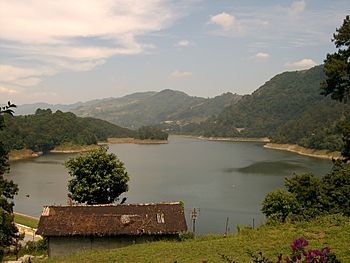Necaxa River facts for kids
Quick facts for kids Necaxa River |
|
|---|---|

The Necaxa River
|
|
| Native name | Río Necaxa (Spanish) |
| country | Mexico |
| states | Hidalgo, Puebla, Veracruz |
| Physical characteristics | |
| River mouth | Tecolutla River |
The Necaxa River (Río Necaxa) is a very important river in the Mexican state of Puebla. It flows into the Tecolutla River. The river starts near Huauchinango and is first called Totolapa. It flows through tall mountains and deep canyons. These are part of the Sierra Madre Oriental mountain range.
Along its path, the Necaxa River creates beautiful waterfalls. These are known as Salto Chico and Salto Grande. The river's strong flow is also used to make electricity. This process is called hydroelectric power.
Contents
Where Does the Necaxa River Flow?
The Necaxa River begins where the states of Hidalgo and Puebla meet. It then flows east through the Sierra Madre Oriental mountains. It passes through parts of Puebla and Veracruz states.
Eventually, the Necaxa River joins another river, the Apulco River. They meet in Espinal, Veracruz. Together, they form the Tecolutla River. The Tecolutla River then flows into the Gulf of Mexico.
How the River Helps Generate Power
The Necaxa River is very important for making electricity. It works with four other rivers: El Tejocotal, Los Reyes, Patla, and Tenango. Together, these rivers provide a huge amount of water. This water helps create electrical power.
This power is used in Puebla and many other states. These include Tlaxcala, Hidalgo, Mexico, and Mexico City. Many people in central Mexico use electricity from these rivers.
Five large dams have been built along the Necaxa River. These dams store water. They help control the river's flow. This stored water is then used to produce hydroelectricity.
Animals and Plants of the Necaxa River Basin
The areas around the Necaxa River's reservoirs are home to many waterfowl. These are birds that live near water. You might see the great egret, which is a large white bird. The snowy egret is another beautiful white bird.
Other birds include the little blue heron and the neotropic cormorant. You might also spot different kinds of kingfishers. These are birds that dive for fish. They include the ringed kingfisher and the green kingfisher.
Endangered Species in the River Basin
Some special animals and plants live in the Necaxa River and its basin. These species are endangered, meaning they are at risk of disappearing. One example is the Puebla frog. This frog is unique to the region.
Another endangered species is a type of tree fern. It is called Cyathea mexicana. Protecting the river basin helps these special species survive.
Necaxa River Basin: A Protected Area
| Zona Protectora Forestal Vedada Cuenca Hidrográfica del Río Necaxa | |
|---|---|
|
IUCN Category VI (Managed Resource Protected Area)
|
|
| Location | Hidalgo and Puebla, Mexico |
| Area | 421.29 km2 (162.66 sq mi) |
| Designation | Natural resources protection area |
| Designated | 2002 |
| Administrator | National Commission of Natural Protected Areas |
| Official name: Sistema de Represas y Corredores biológicos de la Cuenca Hidrográfica del Río Necaxa | |
| Designated: | 2 February 2008 |
| Reference #: | 1796 |
The Necaxa River basin is a special protected area. On October 20, 1938, President Lázaro Cárdenas made it a protected forest zone. This was done to save the forests and climate in the area. It also helped stop soil erosion. Protecting the area also kept the river's flow steady for making electricity.
This protected forest zone is very large. It covers about 421 square kilometers. It includes parts of many towns. These towns are Acaxochitlán, Cuautepec de Hinojosa, Naupan, Huauchinango, Juan Galindo, Xochiltepec, Zihuateutla, Tlaola, Chiconcuautla, Jolalpan, Zacatlán, and Ahuazotepec.
On September 9, 2002, the Mexican government gave the basin a new title. It became a natural resources protection area. This means it is still protected.
Necaxa River Basin as a Ramsar Site
The five reservoirs in the Necaxa River basin are also very important wetlands. On February 2, 2008, they were named a Ramsar site. A Ramsar site is a wetland that is important around the world.
This special Ramsar site covers a total of 1,541.4 hectares. This protection helps keep the wetlands healthy. It also protects the plants and animals that live there.
Can Boats Travel on the Necaxa River?
The Necaxa River is set up for boats to travel on it. The power plant sometimes opens its floodgates. This lets the full river flow. This allows boats to move against the current.
The Necaxa is known as a Class III River. This means it has some rapids. These rapids are usually moderate. They can be exciting for experienced boaters.
How to Visit the Necaxa River Area
If you want to visit the Necaxa River, here's how you can get there from Mexico City. First, take the Mexico-Tuxpan road. Drive until you reach Tulancingo.
From Tulancingo, continue driving to Huauchinango. Your final destination is a place called "El Salto." This is where a hydroelectric plant is located. It's a great spot to see the river and its power.
See also
 In Spanish: Río Necaxa para niños
In Spanish: Río Necaxa para niños


